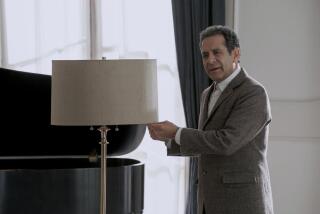Review: âThe Knickâ is a bloody trip back to 1900-style doctoring
You need not worry about âThe Knick.â The Steven Soderbergh-directed period medical drama, which premieres Friday on Cinemax, has already been renewed for a second season, and nothing anyone says or writes about it can hurt it. Weâve all got to go sometime â excuse my bluntness â but unlike many who find themselves in the fictional Knickerbocker Hospital in the city of New York in the year 1900, this patient will live.
It has its problems, its aches and pains, its chronic disabilities. (Read on.) But I am happy enough to hear this news.
An excellent Clive Owen, looking not a little like Edgar Allan Poe, plays Dr. John Thackery, a brilliant, visionary, often arrogant surgeon seeking to complete the work left undone by his late mentor, Dr. J.M. Christenson (Matt Frewer, who continues to show up in flashbacks).
Christensonâs mentoring included the use of cocaine as a work aid, and within the first few minutes of the series, we see Thackery, in the back of a horse-drawn cab, give himself a shot between his toes. The drug, which is also in use through the series as an anesthetic, is to âThe Knickâ what cigarettes are to âMad Menâ â a thing whose badness was understood but not yet accepted, and an occasion now for rueful retrospective humor.
Thackery also has an opium habit, perhaps developed as an antidote to the coke high, and he spends his nights in a Chinatown opium den and brothel, which allows Soderbergh to get a premium-cable-mandated naked girl into his first shot. A few more instances will be forthcoming, but the nudity is moderate by contemporary standards.
For certain things to occur, most notably the unlikely hiring of an also-brilliant, also-visionary black surgeon (AndrĂŠ Holland as Dr. Algernon Edwards), it is necessary for the hospital to be cash-strapped and dependent on the support of progressive philanthropist Cornelia Robertson (Juliet Rylance). The high-class, paying patients are all moving their business uptown, and it doesnât help at all that the man who runs the place (Jeremy Bobb) is embezzling money to pay off a loan shark.
Series creators Jack Amiel and Michael Begler have a background in comedy (âThe Tony Danza Show,â the Garry Marshall film âRaising Helenâ), though there isnât much comedy in âThe Knick,â nor much plot. I have watched seven hours out of the first seasonâs 10, and even as a connoisseur of pokiness, it felt to me that a story, as expressed through character relationships, was slow to form. (Eventually, it does.)
Thatâs not a bad thing, for the series is at its most convincing, and most beautiful, at its most static. When the show bursts into action, or insists upon making its characters intense and extraordinary â some of them fictionally take credit for real-world medical advances and inventions â it grows, paradoxically, proportionally less interesting.
It feels like a catalog drama at times, an illustrated checklist of historical themes, references and diseases, backward-engineered from the research. Typhoid? Syphilis? Meningitis? Check. Telephone, phonograph, bicycle? Check. Vacuum cleaner, X-ray machine? Bonwit Teller, Dr Pepper and the Panama Canal? Rockefellers, Roosevelts and Vanderbilts? Accents to represent neighborhood, ethnicity and class? All present and accounted for.
Much of it feels obvious or familiar. Thackery will remind you and everyone you know of Dr. Gregory House, to start; but heâs a bit of a Don Draper, as well, and other âMad Menâ analogies can be drawn to its cast of characters and edge-of-modernity themes. Certain apparently upright characters will be seen to have feet of clay, just as certain other characters who seem made entirely of clay will prove themselves surprisingly complex. The most interesting performances and best-written characters come from the lower ranks: Chris Sullivan as an aggressive ambulance driver, Cara Seymour as a nun with a sideline, Eve Hewson as a new nurse up from the country.
Except for a few self-consciously âartisticâ passages and some scenes in which the post-production sepia has been dialed up a little too high, the series, with its combination of real, constructed and digital Old New York, looks great. (Production designer Howard Cummings and costume designer Ellen Mirojnick both worked on Soderberghâs Liberace biopic âBehind the Candelabra,â and many big, big-screen productions before it.) The fluid hand-held camera work creates a sense of intimacy; Cliff Martinezâs simmering electronica score builds tension without disrupting the period spell.
The series is often bloody and full of body parts, I suppose I should say, though nothing that viewers of forensic procedurals havenât seen a thousand times. Still, some will want to watch â and, for all my reservations, I do recommend giving âThe Knickâ a try â with a head turned half from the screen. I did, anyway.
Twitter: @LATimesTVLloyd
----------------------------
âThe Knickâ
Where: Cinemax
When: 10 p.m. Friday
Rating: TV-MA (may be unsuitable for children under the age of 17)
More to Read
The biggest entertainment stories
Get our big stories about Hollywood, film, television, music, arts, culture and more right in your inbox as soon as they publish.
You may occasionally receive promotional content from the Los Angeles Times.











